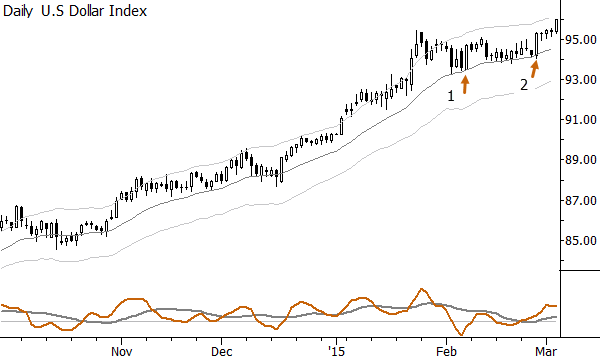We spend a lot of time, as traders, developing skills of precision trading: when to enter trades, where to put stops, when to add, when to take partial profits, when to get out and reenter. Most of the writing about trading, especially from technical or tactical perspectives, focuses on finding tools and patterns that tell us when to act. I think “doing nothing” is one of the key skills of trading, and it might be underappreciated by many traders.

Take a look at the chart of the US Dollar index above. (One of the problems with the index basket is that it is so heavily weighted to the euro–a possible solution is to trade the EURUSD instead, but the concepts apply there, as well.) To put this daily chart in context, the Dollar had been on a historic trend run, was very overextended on weekly and monthly timeframes, and a pullback was probably overdue. But, with a trend this strong, we don’t think about fading the trend, rather, we look for places that the trend will resume following the pullback.
There were a number of false breakouts and false starts on this chart. I’ve marked two of them with 1) and 2), but there were probably others. What if you had entered long at either of those points? If you trade these patterns, you need to think about where and when you would’ve gotten out (or if you would’ve gotten out), and where your risk points for the trades were.
Timeframe is critical here. If you are a short-term daily or intraday trader, you pretty much have no choice but to get in and take some small losses on these trades. That’s certainly a valid plan, but just make sure you understand those small losses do add up. Especially when you are developing a trading plan, it’s easy to say “those are just tiny losses and I can keep looking for the big wins”, but, if you book multiple -0.3R (30% of the initial trade risk, a small loss by most measures) losses, for instance, they can add up pretty quickly.
For longer-term traders, the right thing to do is nothing. This is the message that I find myself reiterating time and time again in interviews, articles, and my published research for my clients. On one hand, it’s a pretty boring message: stay long stocks (which we’ve been saying for years), stay long the Dollar or short opposing currencies, etc’., but it’s also confirmation of and respect for bigger picture market structure. It is liberating to step back and say “I’m going to be hands off here and just let the trade work out”. Remember, too, there is such a large degree of random noise in markets, and micromanaging can easily lead to us getting lost in that noise.
It is certainly possible to trade within those longer term biases, but you just have to be clear on what kind of trader you are and what you will and will not do. If you find yourself nervous about entries and exits, consider backing off, focusing on the bigger picture, and giving your trades a little bit of space to move.